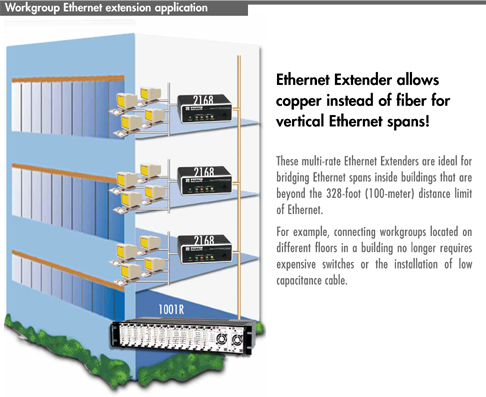How is the CopperLink connection established?
Four steps are required to establish a communications link between the two
Model 2168 Ethernet Extenders (Local
and Remote) and the respective network devices.
1) Connect the 10/100Base-TX devices to the Ethernet port of each 2168 unit.
2) Connect each end of the twisted-pair wire to the CopperLink port of each 2168
unit.
3) Plug the 2168 power supplies into a suitable power source.
4) Plug the output jack of each power supply to the rear power jack of each 2168
unit.
Once powered up, a communications link is established between the two 2168 units
and the CopperLink LED on
each 2168 unit will glow solid green.
NOTE: If line rates are changed from their original settings, both L (Local) and
R (Remote) units must be set to the same line
rate/dip switch settings.
Does the Model 2168 include any management capabilities or test modes?
No, the Model 2168 does not have any management capabilities or test modes.
However, it does feature five
status LED indicators to provide operational status at a glance and assist with
troubleshooting.

What are the distance limitations of the Model 2168 using different gauge
wires?
At the default setting of 12.5 Mbps symmetrical, using 24 AWG (0.5 mm) wire,
the Model 2168 is capable of
providing Ethernet extensions up to 4,656 ft (1.42 km) including the potential
328 ft (100 m) Ethernet connections
on both ends of the communications link. Using 26 AWG (0.4 mm) wire, the Model
2168 is capable of providing
Ethernet extensions up to 3,856 ft (1.18 km). Actual distance and link
performance will vary based on the
environment (cross talk/noise) and type/gauge of wire used. The chart below
shows an example of how the
gauge of wire affects the distance. - - Approximate Distances
 |
|
*NOTE: Distances are based on a minimum to no cross talk environment.
This distance table includes the potential 328ft (100 m) Ethernet
connections on both ends of the communications link.
Can the line rate be altered on the Model 2168 to achieve lower bandwidths
and/or longer
distances?
Yes, the line rate can be altered via dipswitches on the underside of the
2168 Standalone or on the topside of the
front card on the 2168RC. Distances will increase or decrease depending on the
line rate selected. The chart
below shows the possible configurations.
Can the line rate be altered on the Model 2168 to achieve lower bandwidths
and/or longer
distances?
Yes, the line rate can be altered via dipswitches on the underside of the
2168 Standalone or on the topside of the
front card on the 2168RC. Distances will increase or decrease depending on the
line rate selected. The chart on
the next page shows the possible configurations.



 |
|